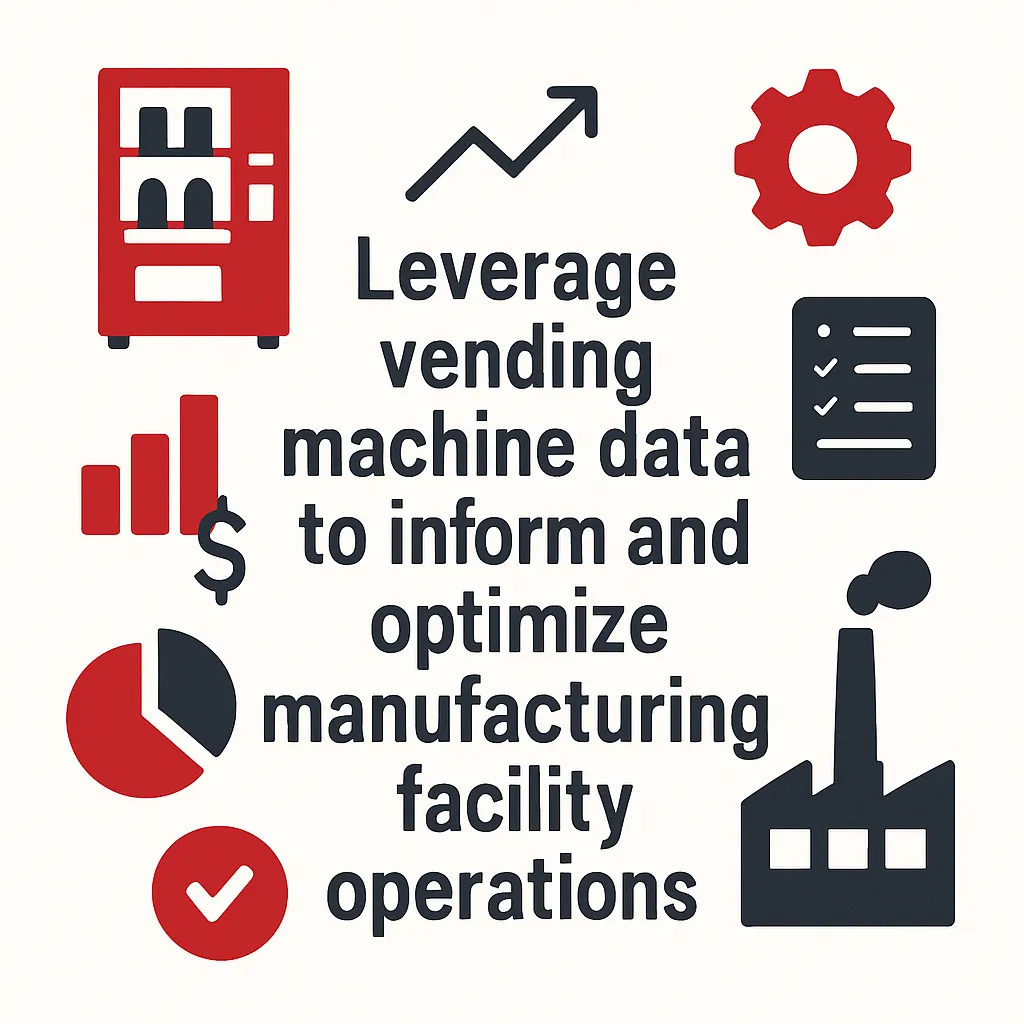Integrating Vending Data with Factory Operations
Leverage vending machine data to inform and optimize manufacturing facility operations. Analyze sales trends and inventory for smarter planning.
Back to Vending for Manufacturing ResourcesLeverage vending machine data to inform and optimize manufacturing facility operations. Analyze sales trends and inventory for smarter planning.
Back to Vending for Manufacturing ResourcesModern vending machines generate valuable data that, when integrated, can provide profound insights into employee patterns, inventory needs, and overall factory efficiency.
![]() Real-time sales insights inform better product selection
Real-time sales insights inform better product selection
![]() Automated inventory tracking reduces stockouts and waste
Automated inventory tracking reduces stockouts and waste
![]() Optimize machine placement based on usage patterns
Optimize machine placement based on usage patterns

Modern manufacturing facilities operate on data. From production metrics to supply chain logistics, every piece of information contributes to optimizing processes and enhancing productivity. Vending machines, often overlooked as simple amenities, are powerful data sources that can provide critical insights when their operational data is properly integrated with factory systems. This integration creates a holistic view of employee behavior, resource consumption, and even real-time equipment status, directly impacting your bottom line.
The detailed sales records from vending machines—which items are purchased, when, and from which location—can reveal valuable patterns. For instance, a surge in energy drink sales in a specific area might indicate long working hours or a particularly demanding production phase. This type of data can inform decisions about snack and beverage options for factory workers, ensuring that employees have access to the refreshments they need to stay alert and productive. Moreover, understanding peak usage times for vending services can help optimize break schedules and staffing allocation on the production floor.
Beyond snacks, specialized industrial vending machines often dispense PPE, tools, and other critical supplies directly to employees. Integrating the usage data from these machines allows factories to implement just-in-time inventory strategies for these items. Real-time tracking of dispensed gloves, safety glasses, or drill bits means fewer stockouts, reduced waste, and better cost control. This granular data can also highlight areas of high consumption, prompting investigations into why certain items are used more frequently in particular zones, which can point to process inefficiencies or specific departmental needs. For comprehensive solutions, explore vending machines for industrial facilities that cater to these specific needs.
Employee satisfaction directly correlates with productivity. By analyzing vending data, facilities can ensure that breakroom offerings align with employee preferences and dietary needs. This data can inform menu adjustments, introduce healthier options, or even identify opportunities for new amenities like coffee services. A factory that proactively addresses employee needs through data-driven decisions fosters a more positive work environment, leading to higher morale and reduced turnover. To learn how other facilities leverage vending for staff, review details on the benefits of vending in industrial settings.
Harnessing vending data is a strategic move for any modern manufacturing facility. It’s not just about providing convenient snacks; it’s about extracting actionable intelligence that can streamline operations, optimize costs, and enhance the overall employee experience. By transforming vending machines into smart data points, factories can achieve a new level of operational sophistication.
It involves connecting data from vending machines within a factory to central operational systems to gain insights for efficiency, inventory, and employee welfare.
Analyzing sales trends can inform optimal restocking schedules, reduce downtime, and identify peak usage times, which can correlate with production cycles.
Data includes sales volume by product, time of purchase, payment methods, inventory levels, machine status, and even employee preferences if linked to internal IDs.
Yes, real-time inventory tracking from vending machines helps predict demand, automate reorders, and ensures that critical supplies or popular items are always available.
Yes, if integrated with employee ID cards or internal payment systems, the data can reveal preferences for catering, break times, and even identify high-demand areas.
Data privacy and security are crucial. Information should be anonymized where possible, comply with privacy regulations, and secured against unauthorized access.
By understanding consumption patterns, factories can better forecast demand for breakroom supplies, PPE from industrial vending, or specific tools, optimizing procurement.
Yes, modern vending machines transmit diagnostic data. This can be integrated to predict maintenance needs, ensuring machines remain operational and minimizing service interruptions.
Typically, this involves telemetry systems in the vending machines, a data aggregation platform, and APIs or custom integrations with a factory's existing ERP or operations management software.
Real-time data enables proactive management of inventory, immediate response to machine issues, dynamic product offering adjustments, and deeper insights into employee needs and factory flow.